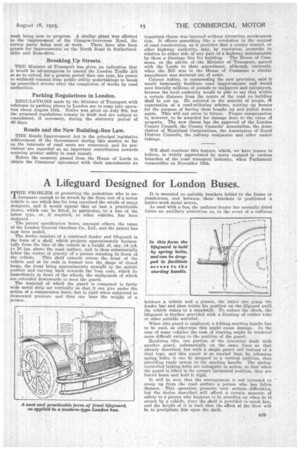A Lifeguard Designed for London Buses.
Page 13

If you've noticed an error in this article please click here to report it so we can fix it.
rrIIIE PROBLEM of protecting the pedestrian who is un fortunate enough to be struck by the front end of a motor vehicle is one which has for long exercised the minds of many designers, and it would appear that ut last a practicable device, whieh can be fitted, in particular, to a bus of the latest type, or, if required, to other vehicles, has been designed.
The patent specification hears, amongst others, the name of the London General Omnibus Co., Ltd., and the patent has naw been sealed.
The device consists of a combined fender and lifeguard in the form of a shelf, which projects approximately horizontally from the face of the vehicle at a height of, say, 14 iug. to 16 ins. above the road surface, and is thus substantially below the centre of gravity of 'a person standing in front of the vehicle. This shelf extends across the front of the vehicle and at its ends is formed into the shape of closed loops, the front being approximately straiat in the middle portion and curving hack towards the 'loop ends, which lie immediately in front of the wheels, the mudguards of ;which are extended downwards to meet the guard. The material of which the guard is composed is fairly wide metal strip set vertically so that it can give under the action of a compression force, but is rigid when subjected to downward pressure and thus can bear the weight of a person. It is mounted on suitable brackets bolted to the frame or dumb-irons, and between these brackets is positioned a lattice-work metal screen.
As used with a bus, the radiator fender bar normally fitted forms an auxiliary protection as, in the event of a collision
between a vehicle and a person, the latter can grasp the fender bar and thus retain his position on the lifguard until the vehicle comes to a standstill. To reduce the shock, the lifeguard is further provided with a fronting of rubber tube or other suitable material.
• When this guard is employed, a folding starting handle bas to he used, as otherwise this might cause damage. In the case of some vehicles the task of starting might be rendered more difficult owing to the position of the guard.
Realizing this, one portion of the invention deals with another guard, substantially on the same lines as that already described, but with a single guard rail instead of a dual type, and 'this guard is so carried that, by releasing spring bolts, it can be dropped to a vertical position, thus providing ready access to the starting handle. The springcontrolled locking, bolts are automatic in action, so that when the guard is lifted to its correct Tiorizontal position, they are forced home and hold it rigid.
It will be seen that the arrangement is not intended to scoop up from the road surface a person who has fallen thereon. This operation presents very serious difficalties, but the device described will afford a certain measure of safety to a person who happens to be standing up when he is struck by a vehicle, since the shelf is provided to catch him, and the height Of it is sueh that the effect of the blow will be to precipitate him upon the shelf.




























